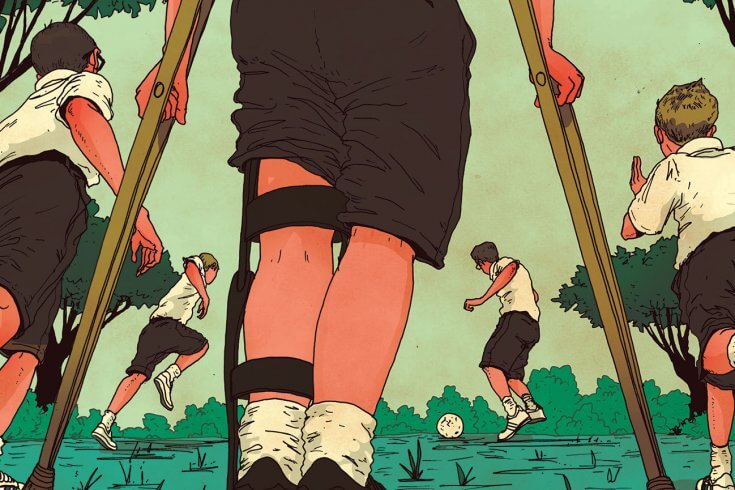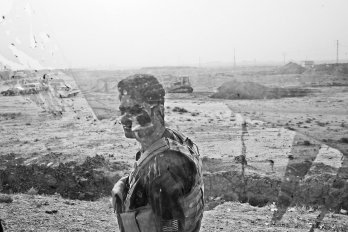It is hard to capture the sense of panic that once gripped cities and towns in North America during “polio season”—summer and early fall. Parents kept children indoors, public places were deserted, quarantines were put in place, and victims were isolated from the healthy. Every year for forty years, from 1910 to 1950, an outbreak of polio took place somewhere in North America, as well as in Europe and in huge swaths of Asia and Africa. The 1953 epidemic was the peak of a new series of infections that had begun in 1949. During those five years, 11,000 Canadians came down with polio, 9,000 in 1953 alone. Newsreels and newspapers depict a country in panic. The medical system was overwhelmed and there was a severe shortage of doctors, nurses, and therapists to deal with the tsunami of cases. City and town councils argued with school officials and public-health officers about whether schools should be opened and pools kept closed, and sometimes vice versa. In big cities, those who had the means fled to cottages and resorts deep in the woods, away from population centres. In a recent Discovery Channel survey of the ten worst epidemics to affect humans, polio still gets top billing, over the 1918 Spanish flu, the Black Death, HIV/AIDS, and malaria.
Polio is a devastating disease, highly infectious, easily transmitted, and with no known cure. The disease attacks the spinal cord and the nervous system, and depending on the severity of the infection and the location on the spinal cord, it can paralyze muscles and tendons.
There are three basic classifications of paralytic poliomyelitis: spinal, bulbar, and bulbospinal, which are simply markers of the region of the central nervous system affected and the amount of inflammation and damage that result. The most common form, spinal, attacks motor neurons associated with the movement of muscles; while it can occasionally affect muscles on both sides of the body, it is usually asymmetrical. About 21 percent of all cases of paralytic polio are bulbar or bulbospinal, and these cases dramatically affect the ability to breathe. When you hear polio and you think iron lung, it is patients with these forms you are picturing.
My parents and their generation were no better equipped to deal with polio than their parents or grandparents had been. Polio was first identified in 1840 and the virus isolated in early 1908, but there is clear evidence stretching back at least as far as ancient Egypt of periodic outbreaks and documented occurrences of the disease.
When I was born, contracting polio was truly a crapshoot. The disease was almost Biblical in the sense of a plague sent down by God and touching houses seemingly at random. My mother and father, like any affected parents in 1953, would have been bewildered as to why their house was targeted and not the family two doors down. Doctors weren’t of much comfort, lacking any explanation for why some caught the virus and others didn’t.
Much of what we now know about polio was just conjecture in the year I was born. Research has proven that polio is transmitted orally from person to person through exposure to fecal matter, which goes some way to explaining why children not yet fully toilet trained are such a prime target. Places where people gather and the virus can easily spread—swimming pools, for instance—are probable hot zones.
Polio is a disease rife with truly tricky numbers, almost inexplicable. For every thousand children under the age of five infected by the virus, only one will show any symptoms; the other 999 move about as normal, except that each is a carrier. The incubation period between infection and the appearance of symptoms is anywhere between three and thirty-five days, and everyone is most infectious in the ten-day period before symptoms can appear. The numbers are crueller for children older than six, and adults, with one out of every seventy-five showing symptoms. The majority will experience what is called “abortive polio” or “non-paralytic polio,” whose symptoms include “fever, sore throat, headache, vomiting, fatigue, back pain or stiffness, neck pain or stiffness, pain or stiffness in the arms or legs, muscle spasms or tenderness, and meningitis.” The unlucky few, just 1 to 3 percent of those who show any symptoms at all, contract paralytic polio and experience loss of reflexes, severe muscle aches or spasms, and loose and floppy limbs, often worse on one side of the body. The onset of the actual paralysis will be sudden and is most often irreversible.
Because polio most often and most seriously affected the young, the disease was commonly referred to as “infantile paralysis.” In the year I was born, little was certain about the disease other than that name, which was enough to chill the soul of even the most devout Catholic.
I was infected at the height of the polio season, in August 1953, just around the time Jonas Salk was performing his trials. His modern medical miracle, however, arrived too late for me. As was the norm at the time, after I fell ill, my family was quarantined. I was isolated in hospital for a year while my parents worried and prayed at home. Isolating polio victims to stem the spread of the virus was known to be futile by 1940, but the practice continued simply to calm the public by creating a sense that something was being done.
The first signs my parents noticed—a high fever, my obvious intense discomfort and stiffness—had them panicked. All babies display a range of behaviours, but this was late summer and polio seemed to be everywhere. I turned out to be one of the lucky ones, because the damage could have been much worse. It is true that my left lower leg didn’t function as such, and this would have serious ramifications over time, but at two months old at least I was alive, and I wasn’t so damaged that I needed to be confined to hospital for years, as was the case with other children. My parents were forced to stay in Deep River, Ontario, my father for work, my mother to care for my siblings. I was entrusted to the staff at the Deep River Hospital and then at Toronto’s Hospital for Sick Children for a year, with my parents visiting when they could.
At the hospital, the staff first examined my stool, then took a throat swab and subjected me to a spinal-tap procedure. These were the only tests available for a relatively quick diagnosis. The gold-standard test involved a long needle and a tricky procedure. In the spinal tap (a lumbar puncture, to use the correct medical terminology) a needle is inserted into the lower part of the spinal cord and cerebrospinal fluid is drawn out and examined for increased white blood cells, higher-than-normal protein levels and the presence of the polio virus. If all three are present, odds are you have paralytic polio. In my case, all three were present.
The procedure is painful for adults and arguably horrific for children. The patient is positioned on his side with his knees drawn up to his chest and his back and neck straightened. The patient must be kept perfectly still, rigid even. For a number of reasons, I would undergo spinal taps at numerous points in my life, and each and every time one was ordered I experienced the closest thing I can imagine to primal dread. Even writing the words spinal tap causes my skin to crawl and my nerves to cringe. In some of the accounts I have read of the panic of the triage rooms in hospitals during the polio epidemics of the 1940s and ’50s, the eeriest reports are those of babies and toddlers moaning as the procedure is performed. I may not remember my first lumbar puncture, but at my core is a clear, affective account of the experience.
In addition to taking the necessary diagnostic steps, the nurses fed me, tried to manage my fever and aches and pains, and, with the doctors and therapists, attempted all the latest treatment fads. This meant immobilizing my left leg, massaging the affected limb, and trying to exercise the other limbs. The muscles in my left leg were paralyzed and immobilizing the limb was believed to be a way to prevent further damage and possibly give the muscles time to heal. The argument over the question of immobility versus exercise went to the very heart of medical authority. I don’t know how my parents reacted to the choice of treatment options at the time, but the way they responded to later medical quandaries and dilemmas, issues I was more aware of and involved with, provided me with some clues. My mom the nurse and my dad the authoritarian were each in their own ways respectful of authority. When faced with conflicting ideas, they would have been worried, panicked, and at a loss as to what was the right thing to do, before finally deciding that leaving the decision to the doctor was both the best and the wisest course of action.
As a baby, not only did I lack the means to tell nurses or doctors what or how I was feeling, but also it wouldn’t always have been clear how I was responding to the various types of treatments and exercises I was being given. Fixing my limbs and moving my limbs would have involved a lot of guesswork and day-to-day adjustments. As a growing baby, my development was soon completely out of whack. At a point when you might expect spontaneous turning and rolling and crawling, I was doing none of that, and no one was quite sure when, how, or if I might start.
I can never be certain how much of my time as an infant being treated in hospital for polio was centred on the Kenny method, named for a world-famous Australian nurse, Sister Elizabeth Kenny. During the 1930s she rebelled against the conventional wisdom of immobilizing, insisting that the best treatment for polio was heat wraps and active and passive exercising of the affected limbs and muscles. It is clear from contemporaneous documents that, as much as possible, nurses and physiotherapists were intent on finding ways to get bodies and limbs moving, and where that wasn’t possible, they put in place the aids and tools necessary to help those who had been paralyzed by polio to adapt.
In my case, at the age of fourteen months, that meant some tendon surgery, where damaged tendons are supplemented by the transfer of healthy ones to weaker areas in the body. You can still see a small scar that travels down the inside of my left leg where an attempt was made to try to repair or supplement the tendons that worked to raise and lower my foot. It didn’t work, but it is my understanding that it was a faint hope anyway. The doctors, the nurses, and my parents all understood that walking was going to be a problem, but they decided to give every option a go before sending me home. As a consequence of the tendon surgery, and in an effort to provide some stability to a baby who had truly limited use of one leg, the doctors put my left leg in a cast, an early version of what we now call a walking cast. The nurses and doctors knew that, once we were home, my learning to walk was going to be a family undertaking. My parents would supply the patience and guidance while I, not yet a year and a half old, would have to supply the stubbornness.
This appeared in the June 2015 issue.






